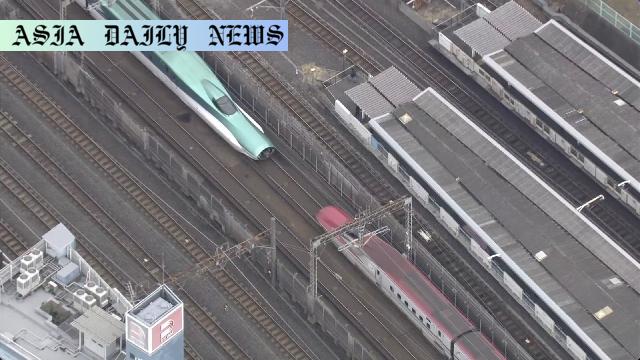Shinkansen: East Japan Railway resumes coupled trains gradually from Friday after resolving issues related to a detachment incident.
Shinkansen services to restart on Friday after temporary suspension.
JR East investigates electrical abnormality as a potential cause.
New safety measures are being implemented with metal fittings.
Japan Transport Safety Board continues its investigation into the issue.

Introduction: The Shinkansen Decoupling Incident
The East Japan Railway Company (JR East) announced the gradual resumption of its coupled Shinkansen trains following an unprecedented decoupling incident. The event, which occurred last Thursday on the Tohoku Shinkansen line, involved the uncoupling of the Hayabusa and Komachi trains while traveling through Tokyo. This prompted JR East to temporarily suspend all linked bullet train services. Following several investigations and measures to enhance safety systems, the train operator has scheduled operations to restart on Friday, with full restoration expected by Saturday.
Details of the Incident and Immediate Response
During a routine journey, the coupling system on the Komachi train exhibited unusual movements that signaled detachment concerns. This was the first time such an issue was recorded in the history of the Shinkansen. Preliminary inspections suggested electrical abnormalities as a potential cause but failed to identify a definitive reason. Consequently, all coupled operations across the Hayabusa and Komachi fleets were halted to prevent further risks. JR East prioritized passenger safety, employing rigorous inspection procedures, while the Japan Transport Safety Board (JTSB) initiated an in-depth investigation to analyze the decoupling mechanism and root causes of the issue.
Safety Measures to Prevent Future Incidents
In response to the incident, JR East has implemented enhanced safety protocols. The connecting part of the trains now features metal fittings as a safeguard against future detachment incidents, even if an electrical malfunction occurs. Engineers tested the new safety mechanism through trial runs to ensure its reliability. These updates aim to maintain passenger trust and uphold the Shinkansen’s reputation for unparalleled safety and efficiency. Furthermore, JR East remains committed to working closely with the JTSB and other external safety authorities to ensure similar incidents do not recur.
The Role of the Japan Transport Safety Board
JTSB officials are actively investigating to identify the causes behind the decoupling. This has involved interviewing train crews, analyzing mechanical and electrical systems, and conducting an overall assessment of operational procedures. Their findings will play a critical role in shaping Japan’s future safety standards across all Shinkansen operations. This collaborative effort between JR East and the JTSB exemplifies the proactive measures taken by Japan to preserve its position as a global leader in high-speed rail technology.
Conclusion: Shinkansen’s Resilience Amid Challenges
Despite the challenges posed by the decoupling incident, JR East’s swift and transparent actions underscore their commitment to passenger safety. The resumption of services marks a significant step forward in rebuilding public confidence, ensuring that such occurrences remain anomalies in the system. The incorporation of new safety measures, coupled with an ongoing investigation by the JTSB, shows Japan’s dedication to upholding its stringent safety protocols and advancing its rail industry. As Shinkansen services resume, passengers can once again experience the reliability and convenience of one of the world’s most advanced transportation systems.



Commentary
The Importance of Safety in High-Speed Rail
The recent Shinkansen incident provides a unique opportunity to discuss the fundamental importance of safety in modern public transportation systems. Japan’s high-speed rail network has long been recognized not just for its speed but also for its unwavering dedication to passenger safety. It is essential that incidents like these are addressed both transparently and effectively, as they impact public confidence in the reliability of the service. The prompt response by JR East, including temporary halts and detailed investigations, reflects their awareness of this responsibility.
Proactive Measures Speak Volumes
What stands out in this case is JR East’s proactive approach. Implementing new safeguards such as using metal fittings to prevent future detachment incidents demonstrates their ability to adapt and improve. This is a testament to the sophistication of Japan’s rail infrastructure. While accidents can occur even in the most advanced systems, it is the response and measures taken afterward that truly define operational excellence. Passengers can find reassurance in the fact that rigorous testing accompanies these new measures.
Lessons for Global Rail Operators
This incident also provides critical lessons for international rail operators. High-speed trains operate in complex environments where even minor technical glitches can pose significant risks. The focus should always be on preventive maintenance and regular audits of equipment. Sharing knowledge and findings from the Shinkansen with other nations could pave the way for collaborative improvements in rail safety worldwide. Japan’s exemplary handling of this matter not only strengthens public trust domestically but also reinforces its status as a global leader in transportation technology.
Looking Ahead with Confidence
As Shinkansen services gradually return to normal, the real victory lies in how this challenge was addressed. By placing passenger safety at the forefront of their response, JR East reinforces the idea that the reputation of a service is built not just on its daily operations but also on how it handles crises. The traveling public can look forward to a safer, more reliable journey moving forward, with lessons learned ensuring a brighter and more secure future for high-speed rail globally.